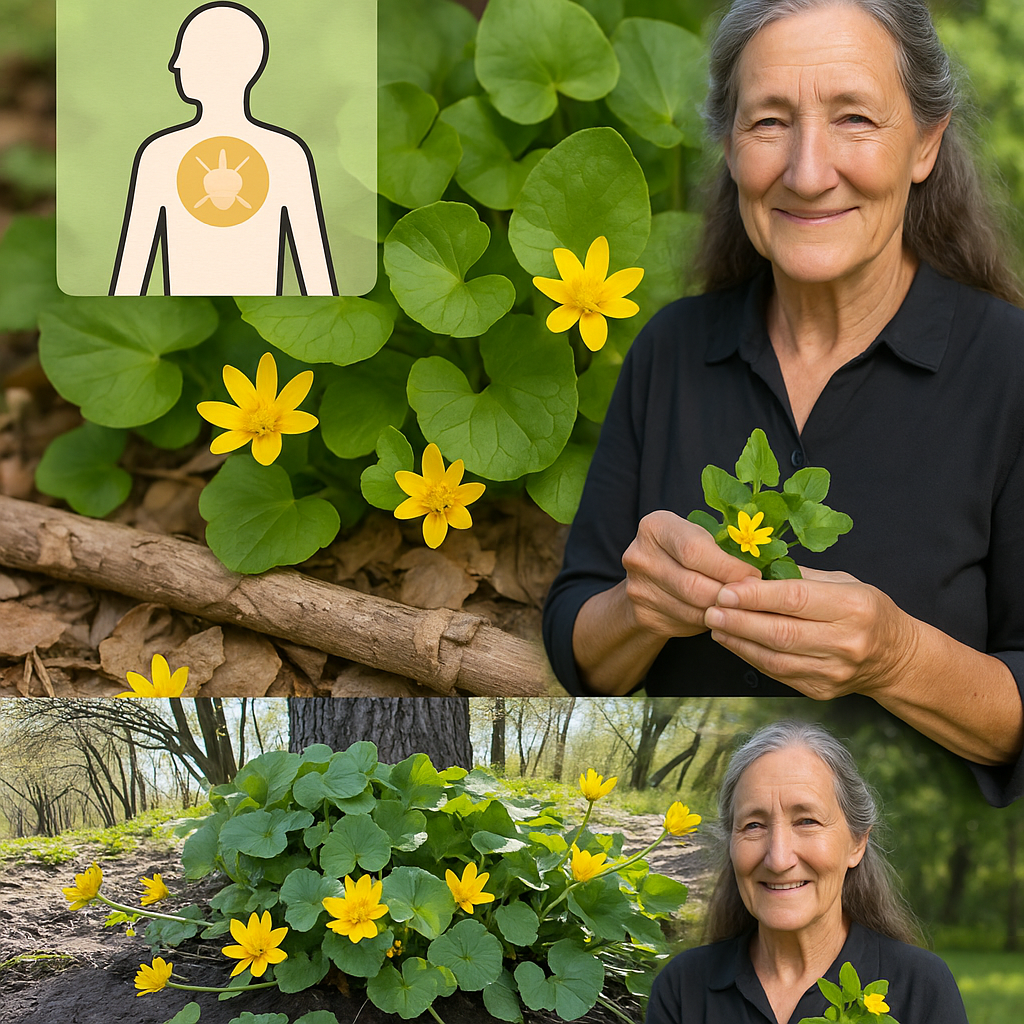In the soft light of early spring, a carpet of small yellow flowers begins to bloom across forest floors, garden edges, and riverbanks. It’s a sight of renewal — and also a powerful herbal warning. This vibrant little plant is Lesser Celandine (Ficaria verna), once revered as a traditional remedy, especially for hemorrhoids, yet dangerously toxic in its raw state.
Like many plants in the buttercup family, Lesser Celandine demands respect. It is both a symbol of healing and a reminder that nature’s medicine must be handled with knowledge and care. If you’ve ever considered foraging or experimenting with herbal skincare, this is one plant you should understand completely before use.
Let’s take a close look at the potent properties and critical cautions surrounding this intriguing spring herb.

🌿 What Is Lesser Celandine?
Lesser Celandine, also known historically as “Pilewort,” is a low-growing perennial with glossy, heart-shaped leaves and bright, star-like yellow flowers. It belongs to the Ranunculaceae family and is commonly found in moist environments throughout Europe and North America.
In centuries past, herbalists believed that a plant’s appearance often indicated its use. The small root nodules of Lesser Celandine were thought to resemble hemorrhoids, leading to its traditional use for that very condition.
But traditional knowledge also included a serious understanding: this plant can only be used after proper preparation.
🌿 6 Traditional Benefits of Lesser Celandine (When Properly Processed)
🌸 1. Hemorrhoid Relief
This was Lesser Celandine’s most famous use. The astringent compounds, when applied in a sitz bath or infused into an ointment, were believed to reduce swelling, soothe irritation, and promote healing of sensitive tissues. It became so well-known for this that its nickname “Pilewort” stuck for generations.
🧴 2. Astringent and Tissue-Tightening Effects
The plant’s tannins help tone and tighten tissues, which made it a popular folk remedy for moist wounds, ulcers, or skin that needed drying out gently — much like witch hazel today.
🩹 3. Topical Wound Healing
Mashed dried leaves were applied externally to minor cuts, insect bites, and inflammation. In the pre-antibiotic era, it was one of several plants believed to help prevent infection and promote scab formation.
💧 4. Varicose Vein Support
Some historical ointments included Lesser Celandine to relieve the visual and physical discomfort of varicose veins. The anti-inflammatory qualities of the dried or boiled plant were valued for soothing surface veins.
🍵 5. Seasonal Cleanse in Spring
In traditional springtime remedies, small amounts of the dried plant were used in detox blends to support liver and digestive health. It was thought to “wake up” the body after a heavy winter diet.
🔥 6. Anti-inflammatory Benefits
When prepared as an oil or salve, Lesser Celandine could be applied to sore muscles, swollen joints, or bruises. It was used much like arnica today — externally only and in properly processed form.
⚠️ The Toxic Truth: What You Must Know Before Using Lesser Celandine
🌿 1. It’s Toxic When Fresh
Fresh Lesser Celandine contains protoanemonin, a chemical irritant that can cause blisters on the skin and serious stomach upset — or worse — if ingested. Even handling large amounts with bare hands can cause dermatitis in some people.
🔥 2. Safe Only When Dried or Heated
Drying or boiling the plant neutralizes the dangerous protoanemonin, converting it into a safe form known as anemonin. This is why folk medicine recipes used dried powders, boiled teas, or oil infusions — never fresh preparations.
🚫 3. Not Recommended for Internal Use Today
Modern herbalists largely avoid internal use of Lesser Celandine due to the risk of toxicity, variability in plant potency, and availability of safer alternatives.
🔍 4. Can Cause Skin Reactions Even When Used Externally
Some individuals develop contact dermatitis even from touching the plant. Always test a small area first, and never use the raw plant directly on the skin.

🛠️ Safe and Traditional Ways to Use Lesser Celandine
✔️ Sitz Baths for Hemorrhoids
Simmer 1–2 tablespoons of dried Lesser Celandine in 2 cups of water for 10–15 minutes. Strain and add to a shallow sitz bath. Use once daily during flare-ups.
✔️ Herbal Salve for Skin Irritations
Infuse dried leaves in olive oil for several weeks, then strain and blend with beeswax to make a healing salve. Apply to external skin areas only — never open wounds.
✔️ Poultices for Bruising or Swelling
Prepare a cooled decoction using the dried plant, soak a cloth in the liquid, and apply as a compress to sore muscles or minor varicose veins.
✔️ Spring Detox (With Expert Guidance Only)
A small amount of dried Lesser Celandine may be included in traditional cleansing teas, but this should only be done with professional herbalist supervision. Safer detox herbs like dandelion or burdock are strongly preferred today.
🌼 Lesser Celandine vs. Other Herbs: Safer Alternatives
If you’re looking for the benefits without the risk, consider these gentle substitutes:
• For hemorrhoid relief: Witch hazel or calendula
• For skin healing: Plantain (Plantago major) or chamomile
• For spring detox: Dandelion root or nettle leaf
• For varicose veins: Horse chestnut extract or yarrow
⚠️ Final Word of Caution
Natural doesn’t always mean safe. Lesser Celandine is a perfect example of a plant that holds healing potential — but only in experienced hands. If you’re new to herbal medicine, it’s best to admire this cheerful springtime flower in nature and leave its medicinal use to experts.
Disclaimer
This content is for informational purposes only and not intended as medical advice. Always consult a licensed healthcare provider or professional herbalist before using any wild or unfamiliar plant, especially one known to contain toxic compounds. Never consume raw Lesser Celandine or apply it directly to broken skin.


